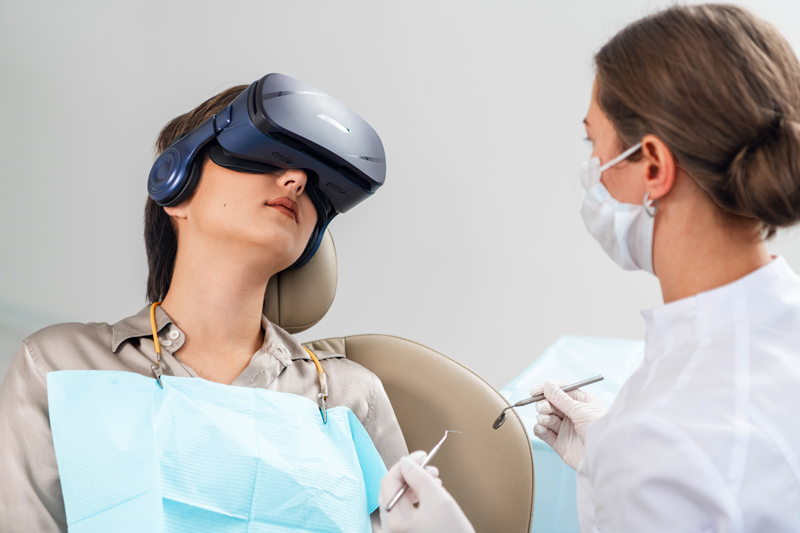For patients with autism, getting healthcare is often a struggle. My views in healthcare were heavily influenced by watching my brother, who was non-verbal and autistic, and my mother navigate the healthcare system with much difficulty. He, like many patients with autism, struggled with doctor visits so much that he missed out on much-needed care.

It’s estimated that 1 in 44 children have a form of autism spectrum disorder (ASD).1 Although the United States has made strides in improving awareness about ASD, there is still much to be improved on how they receive healthcare. Virtual reality (VR) is hoping to help with that.
How Virtual Reality Helps with Healthcare Anxiety
Children with and without autism often have needle phobia. This can make routine procedures unbearable and can lead to healthcare anxiety. It is not uncommon for a child to need to be restrained in order to administer a shot or vaccine safely.
One of my patients suffered from extreme needle phobia. We decided to leverage the power of virtual reality to improve his experience. Virtual reality in pain management takes advantage of how our brain processes pain. If we were able to change a patient’s negative perception of a needle procedure we could also change their negative reaction. VR does this by transporting them to a different environment – such as an undersea water adventure. While the injection site was being prepared, all he could see and feel were waves and fish nibbling on his arm – both of which he loved. Surrounding him in a safe and calm environment allowed him to be fully vaccinated with less fear and pain.
This method is called procedural choreography, where real-world negative and painful stimuli are replaced by virtual stimuli filled with positive and friendly images.
How Virtual Reality Helps with Phobia Management
Virtual reality can also offer a safe space to manage the phobias of those with autism. Common phobias of those with autism are often fear of crowded places or small, enclosed spaces – such as MRI machines. It causes what they call sensory overload, where intense stimulus overwhelms them beyond an ability to cope.
Virtual reality allows them to be exposed to their phobia in a controlled environment. For patients with autism who have to undergo MRI, virtual reality is used to slowly expose them to a stimulated MRI and assess their ability to withstand the procedure. This can reduce their fear and anxiety and lessen the need for them to be sedated.
Studies have shown that virtual reality has drastically improved the healthcare experience. Clinical trials are showing with the use of VR there is a 60% reduction in pain, a 40% reduction in anxiety, and cut in half the need to physically restrain patients for needle procedures.2 Caregivers have seen an improvement in their child’s experience as well, with caregivers rating their child’s distress levels 75% less than caregivers whose children did not receive virtual reality.
The Future of Healthcare for Patients with Autism
As a healthcare provider, it has always pained me to know that there are those who struggle with healthcare so much that they seek to avoid medical help altogether. As someone who joined healthcare with a mission to serve and help, it was always my goal to find ways to improve the clinical experience for all my patients – especially those who were underserved. The goal of improving the experiences of patients like my brother has always driven my passion for innovation.
Virtual reality is slowly becoming the standard of care to help reduce pain and anxiety for those who struggle with phobias and healthcare anxiety. VR has the potential to alleviate fears and manage various conditions in children with autism by changing their situational perception and immersing them in a safe and controlled environment.
Evelyn Chan, MD, is the CEO and founder of SmileyScope, a virtual reality solution for needle procedures used by healthcare practitioners. Evelyn is a Medical Doctor (Pediatrics) and a Rhodes Scholar. In 2017, Evelyn took her experience working with children and developed a first-of-its-kind medical VR device. You can learn more about her on LinkedIn.
Footnotes
- Centers for Disease Control and Prevention. (2022, December 15). Autism and developmental disabilities monitoring (ADDM) network. Centers for Disease Control and Prevention. Retrieved March 9, 2023, from https://www.cdc.gov/ncbddd/autism/addm.html#:~:text=CDC%20estimates%20that%20about%201,8%2Dyear%2Dolds.
- Chan E, et al. Virtual reality for pediatric needle procedural pain: two randomized clinical trials. J Pediatr. 2019;209:160-167.e4. [PubMed]





